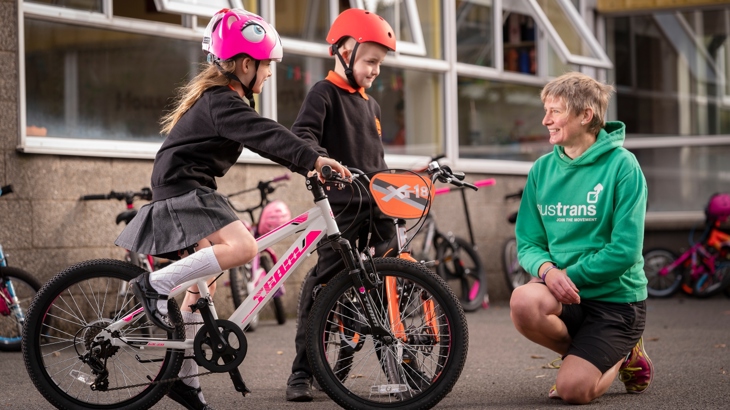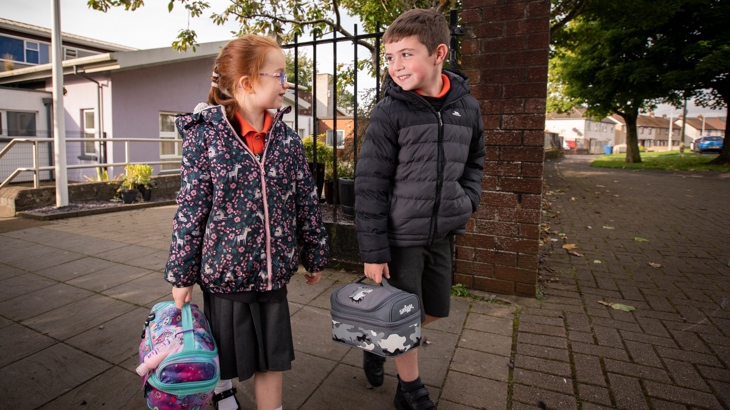Our award-winning Active School Travel Programme in Northern Ireland has increased the number of children walking, wheeling and cycling to school. But with rising numbers of children being driven to school across the country, there is much more important work to be done.

Pupils at Linn Primary School in Larne, Northern Ireland get tips on safe cycling from Sustrans Active School Travel Officer, Beverley Gaston. Credit: Brian Morrison
Our Active School Travel Programme has worked with more than 200 schools in Northern Ireland over the past year [1].
Our schools officers have been on a mission to buck the worrying trend that most primary age school children in Northern Ireland are being driven to school.
We are funded to deliver this programme by the Public Health Agency and the Department for Infrastructure until July 2022.
Localised success stories
At the end of the 2020-2021 school year, the number of children travelling actively to school increased from 31% to 43% at participating schools.
At the same time, the number of pupils being driven to school fell from 61% to 50%.
After one year in the programme, the number of children completing the Chief Medical Officer's recommended amount of physical activity (at least 60 minutes each day) increased from 26% to 41%.
And our own surveys reveal that 80% of children would like to travel actively to school.
Congestion and air pollution remain a national problem
In spite of the fantastic progress made by schools in the programme, the problem of congestion and air pollution around schools continues to increase, as more children than ever are being driven to school.
Government statistics reveal that the number of primary school pupils being driven to school across Northern Ireland has risen to 68%.
Despite nearly half of these children (46%) living within a mile of their school [2].
It is estimated that one in five cars in Northern Ireland's rush hour is on a school run.
Beth Harding, Sustrans Active School Travel Manager said:
“We are delighted with the results of the programme over the past year, especially in light of the additional challenges set by Covid.
"It is clear evidence that we can reverse the trend of children being driven to school.
“But the 209 schools we've worked with, represent only one fifth of the total number in Northern Ireland.
"There is so much more we can do if the programme can continue beyond July 2022.
"Including providing safer infrastructure for schools to tackle the overall trend.”

Pupils at Linn Primary School in Larne, Northern Ireland ready to walk to and from school. Credit: Brian Morrison Photography
Improving the quality of life for everyone in Northern Ireland
School principal Fiachra Ó Donghaile of Gaelscoil na Daróige in Derry-Londonderry, said:
“We wanted to reduce pollution and congestion, and increase exercise.
"The Active School Travel Programme has helped us to embed new travel habits and encouraged a significant number of families to engage in active travel.”
Infrastructure Minister, Nichola Mallon added:
“I am delighted that the results of the Active School Travel Programme over the past year show that this programme, jointly funded by my Department and the Public Health Agency, has been successful in encouraging children from participating schools to choose to travel actively.
“I would encourage more families and children to make the move to more active ways to get to and from school.
"Walking, wheeling or cycling to school improves children’s health, confidence and concentration.
"As well as teaching them the rules of the road and how to walk and cycle safely.
"Active travel not only benefits our own individual health but also helps to tackle the climate emergency by cutting down traffic congestion and reducing air pollution.
"Thereby improving the quality of life for everyone in Northern Ireland.
“We all need to encourage each other to continue making the shift towards active modes of travel, especially for those shorter journeys.
"Together we can bring real and lasting change to our society by creating greener, cleaner and healthier places for us all.”
Dr Hannah Dearie from the Public Health Agency commented:
"We are delighted to work in partnership with the Department for Infrastructure and Sustrans on the Active School Travel Programme.
"The programme is designed to help increase levels of physical activity, in line with Chief Medical Officer’s guidelines.
"As many as one in four children aged between 2 and 15 years old are overweight or obese in Northern Ireland and programmes like this are helping to reduce these rates.
"The programme is fun, safe, interactive and has the further benefit of supporting children’s mental health.”
Read more in the Active School Travel Programme 2020-2021 Summary Report.
Find out how the Active School Travel Programme is successfully working to increase the number of children walking, wheeling and cycling to school in Northern Ireland.
[1] In total, 437 schools participated in the programme in 2020-2021. 209 schools received direct support from a Sustrans Active Travel Officer. The remaining 228 schools received light-touch extended support, following three previous years of direct engagement. Results are taken from the 209 schools supported directly in 2020-2021.
[2] Department for Infrastructure's Travel to and from School by pupils in Northern Ireland 2019/20 report.





